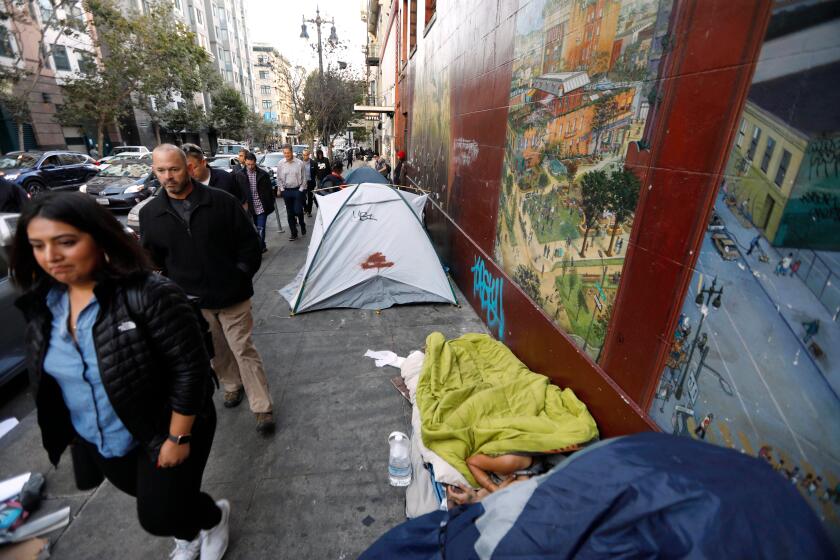California unemployment falls to its lowest rate in more than four decades
- Share via
California’s job market powered ahead in October as the unemployment rate dropped to a new low and payrolls continued to grow in the state’s longest expansion on record.
At 3.9%, the jobless rate was the lowest since 1976, when the state changed its statistical methodology, adding new data to its calculations, state officials reported Friday. That was down from 4% in September, and 4.1% a year earlier.
“Each month we think we can’t get any lower in the unemployment rate, but we do,” said Michael Bernick, a former director of the California Employment Development Department. “This is comparable to the rates we had in the 1950s.”
Nationwide, the jobless rate stood at 3.6% in October, also near a half-century low.
Wage inequality has risen more in California cities than in the metropolitan areas of any other state, with seven of the nation’s 15 most unequal cities located in the Golden State.
Golden State employers added a net 23,600 jobs in October, for a total of 17.56 million, and a year-over-year growth rate of 1.8%. U.S. payrolls grew by 1.4% year-over-year.
The state’s monthly gain was “healthy,” said Scott Anderson, chief economist of the San Francisco-based Bank of the West. “California’s labor market has been surprisingly resilient this year, despite the head winds from the U.S.-China trade war and global manufacturing recession,” he said.
Since the Great Recession ended in February 2010, the state has added more than 3.37 million payroll jobs. That 116-month growth surpassed the long expansion of the 1960s, EDD officials noted, accounting for more than 15% of the nation’s job gains over the same period.
California’s economy “appears to be bucking the national trend of slower growth this year,” Anderson said. In January, the state’s payrolls rose year over year by 1.5%, compared with last month’s 1.8% growth. Over the same period, U.S. nonfarm job growth slowed from 1.9% to 1.4%.
Sectors adding the most jobs over the year were education and health services (90,800); professional and business services (62,600); leisure and hospitality (48,800); and government (36,700).
But the expansion was broad-based: Every sector grew except mining and logging, which remained flat. Other expanding categories included construction (34,400); manufacturing (11,600); financial activities (13,500); trade, transportation and utilities (7,100); other services (1,300); and information (1,200).
Robots are coming to the massive ports of Los Angeles and Long Beach, replacing dockworker jobs. But truckers are delighted, since they’ll be able to move cargo faster, earning more money.
Economists look not just to job growth and unemployment rates as key indicators of economic health, but also to the size of the labor force, and California’s labor force grew substantially for the second month in a row. The addition of 40,800 more workers and job seekers in October “could indicate that people are finally becoming confident enough to enter or reenter the workforce to find jobs,” said Lynn Reaser, an economist at San Diego’s Point Loma Nazarene University.
However, the longer-term trend seems less encouraging. California’s labor force peaked in February this year. Year over year, it has shrunk by 57,400 workers, noted Taner Osman, a researcher at the Los Angeles consultancy Beacon Economics.
However, he added, “It’s too early to read too much into these numbers. Generally, the supply of housing and the cost of living in the state constrain the growth of the labor force. “
Among Southern California counties, Los Angeles had the highest unemployment rate in October, at 4.5%, followed by Riverside (3.9%), San Bernardino (3.5%) Ventura (3.3%), San Diego (2.8%) and Orange (2.5%).
Over the last year, the Inland Empire and San Diego County experienced 2% job growth, the fastest in Southern California, followed by Los Angeles County (1.3%) and Orange County (1.2%).
The booming Bay Area technology scene is driving an ever-tighter job market. Unemployment in the region is below 2.6%, and is as low as 1.7% in San Mateo County. San Francisco had 3.5% job growth, followed by San Jose (3%), San Rafael (2.8%) and the East Bay (2.2%).
More to Read
Inside the business of entertainment
The Wide Shot brings you news, analysis and insights on everything from streaming wars to production — and what it all means for the future.
You may occasionally receive promotional content from the Los Angeles Times.












